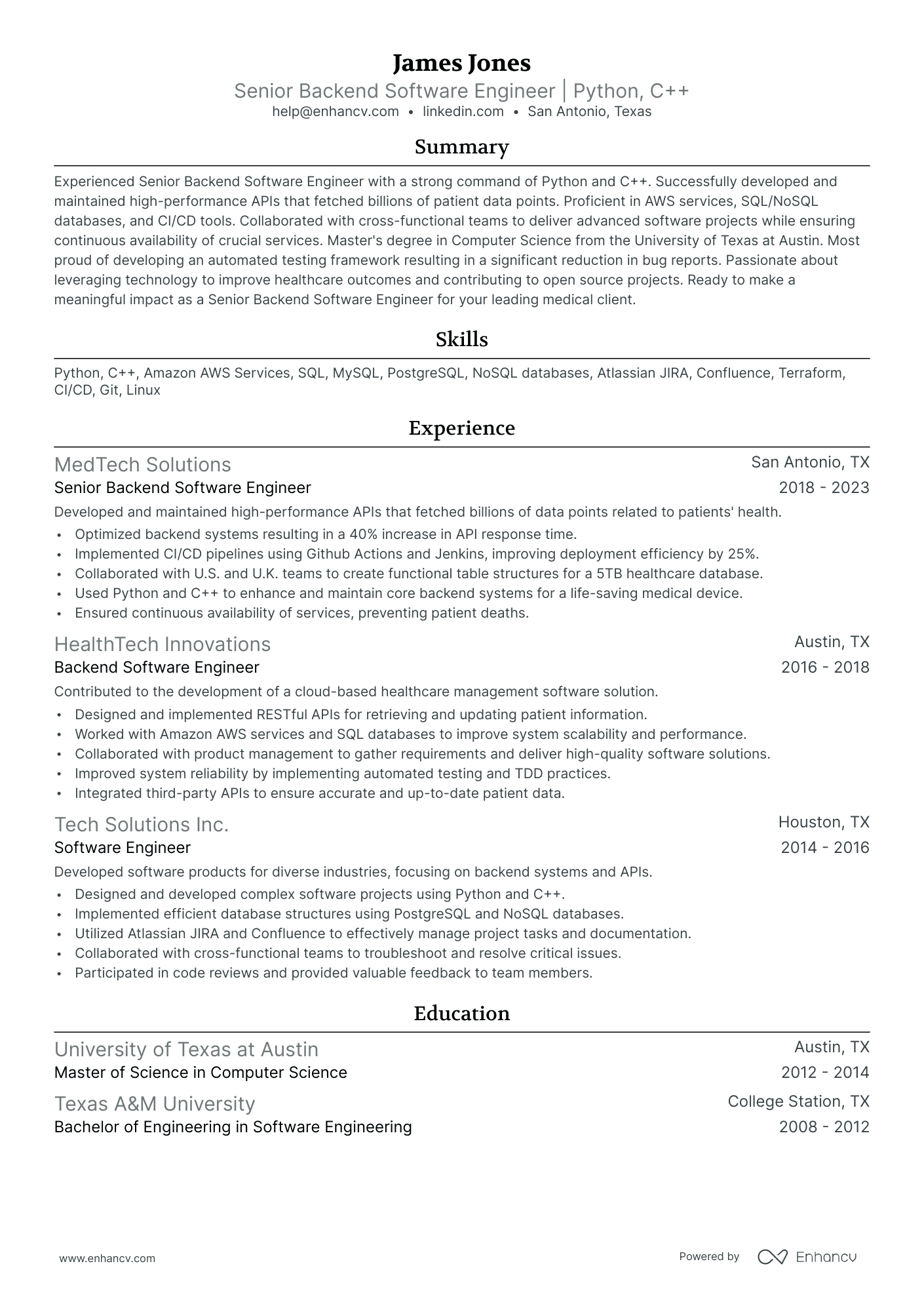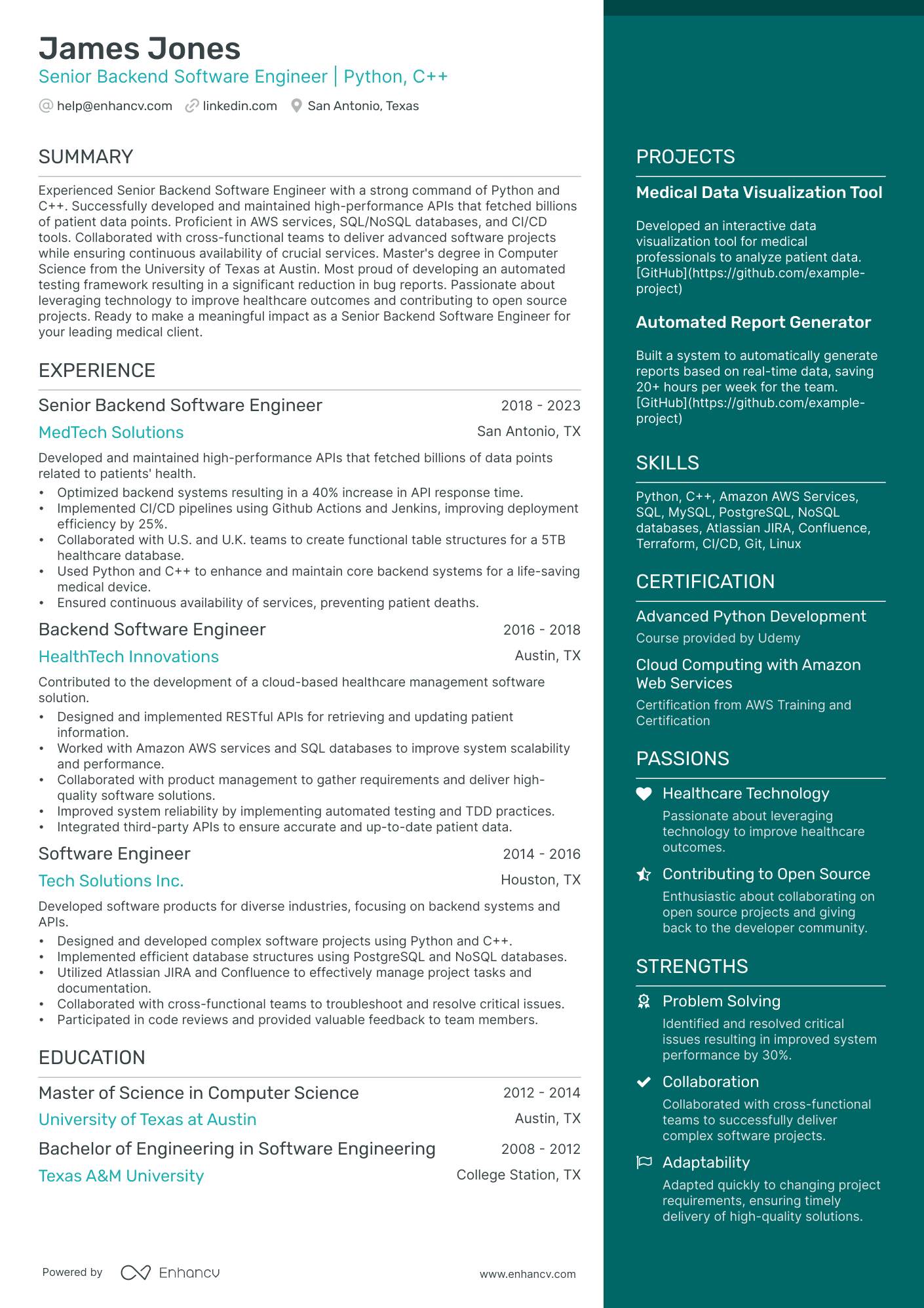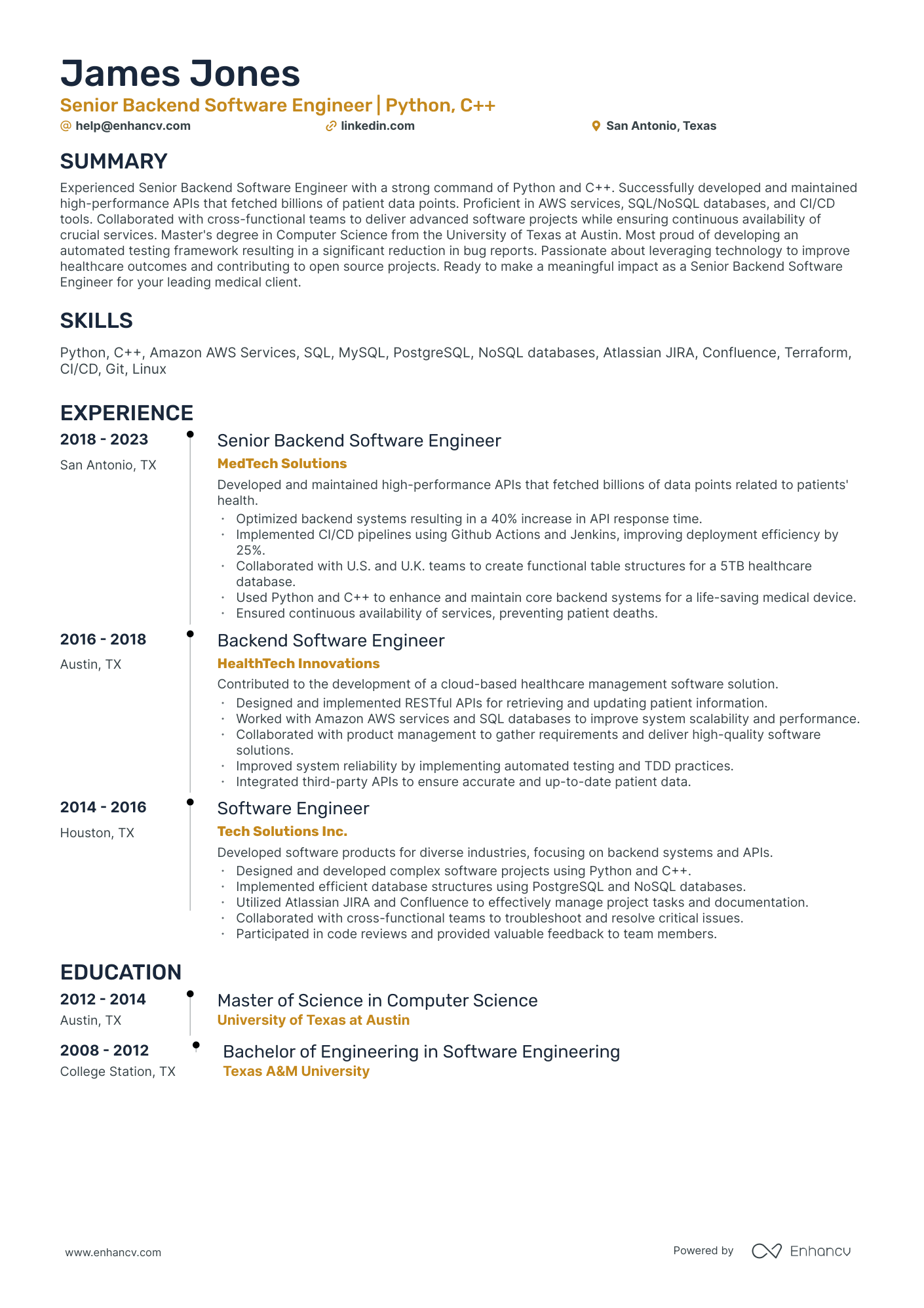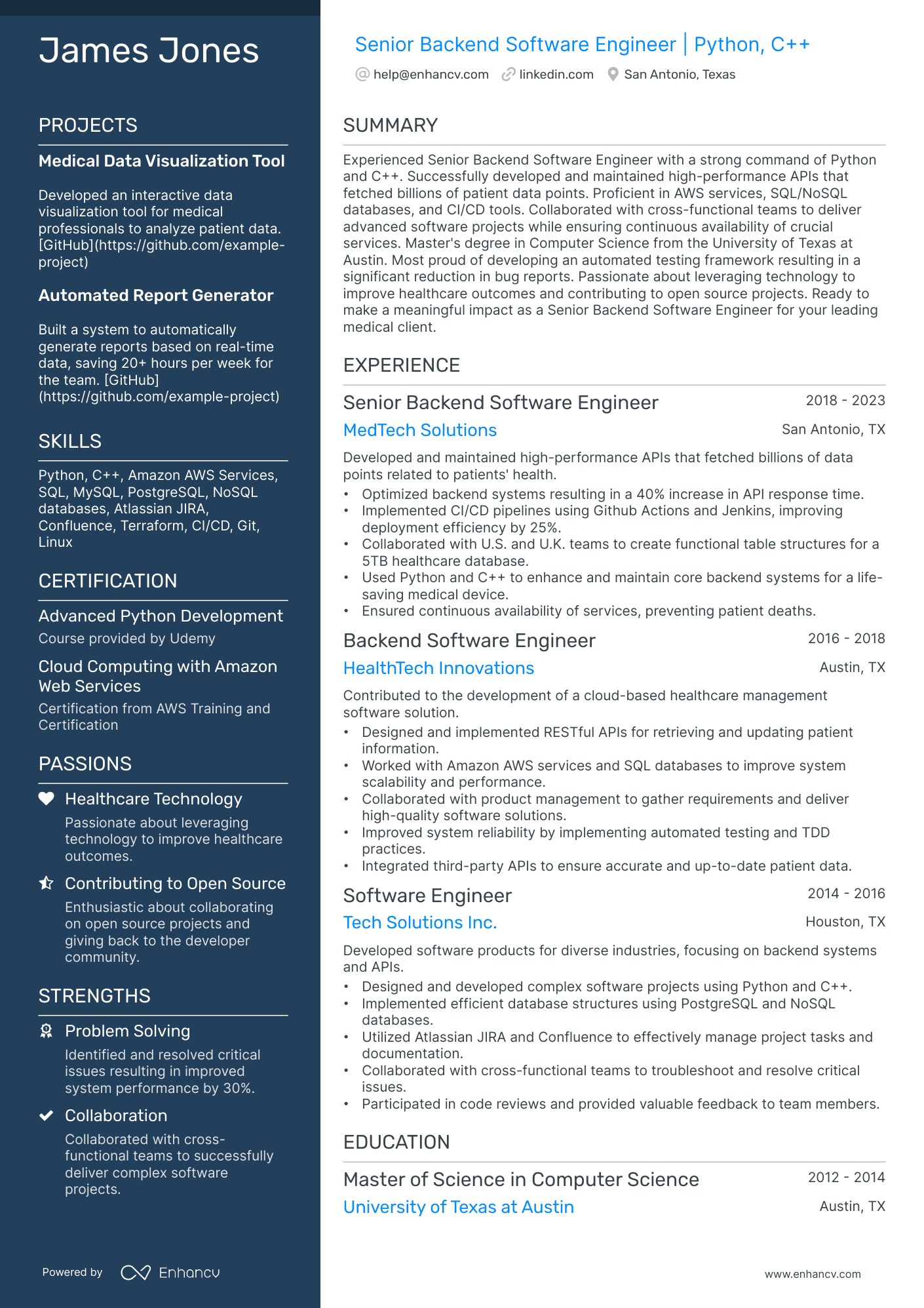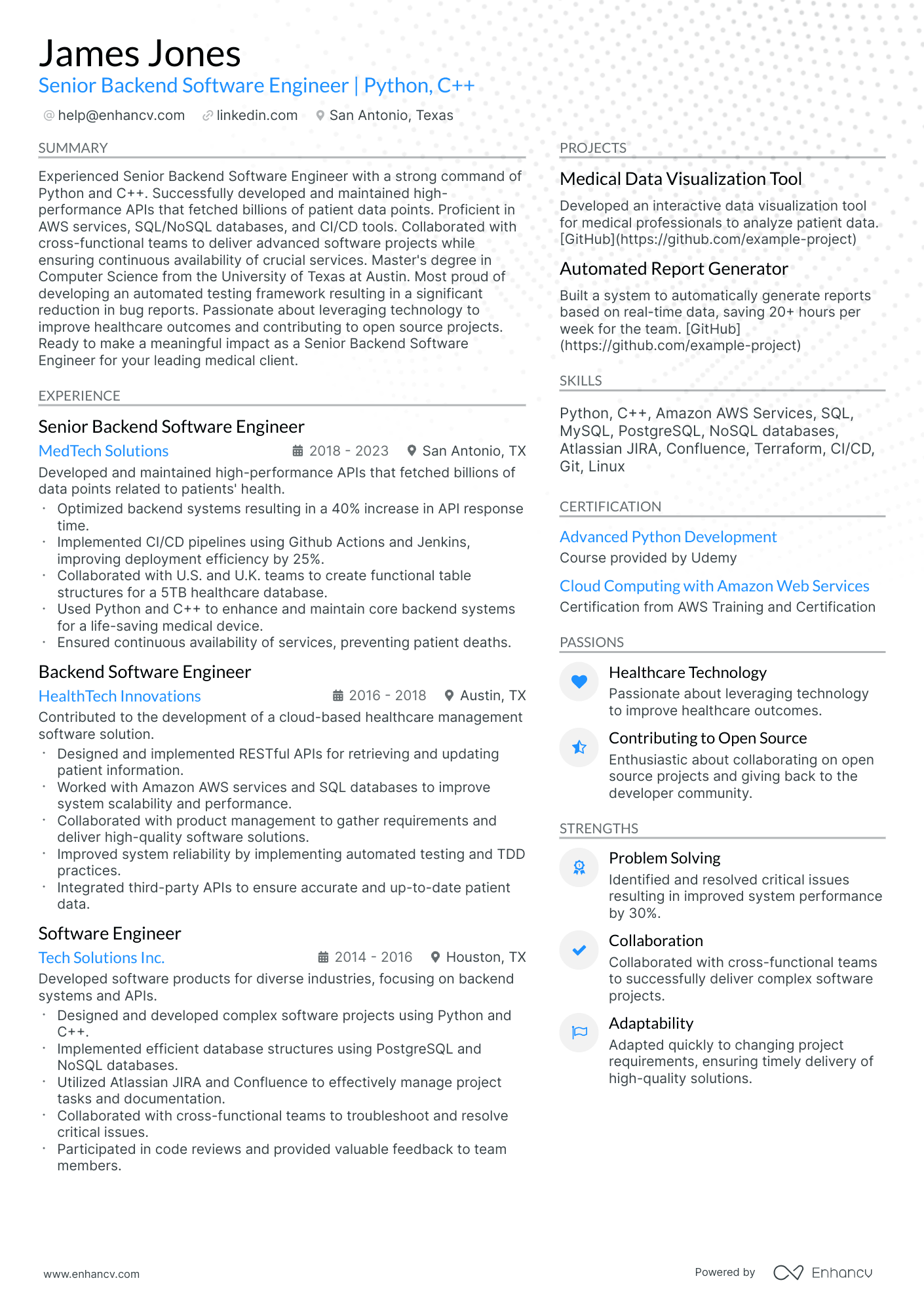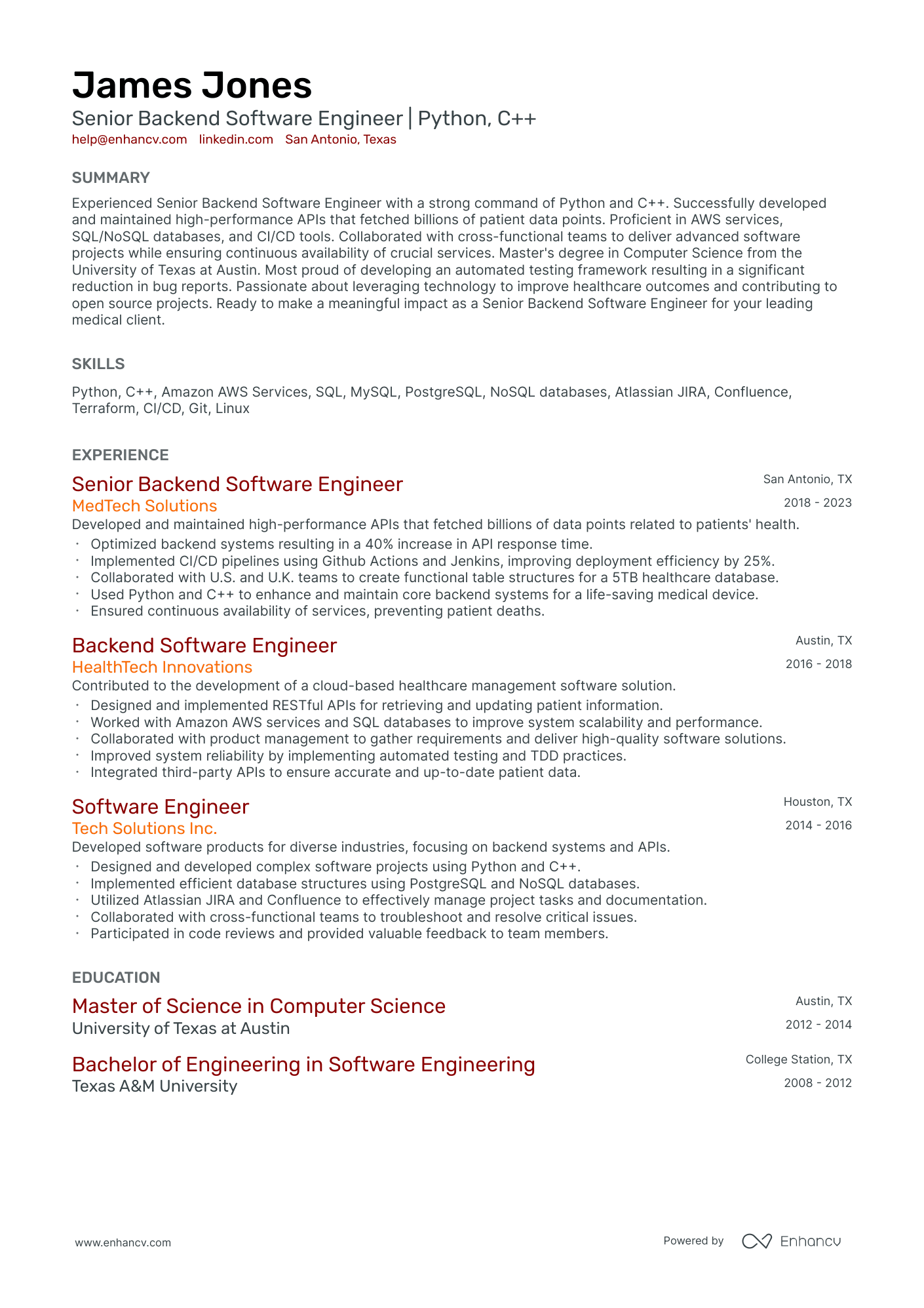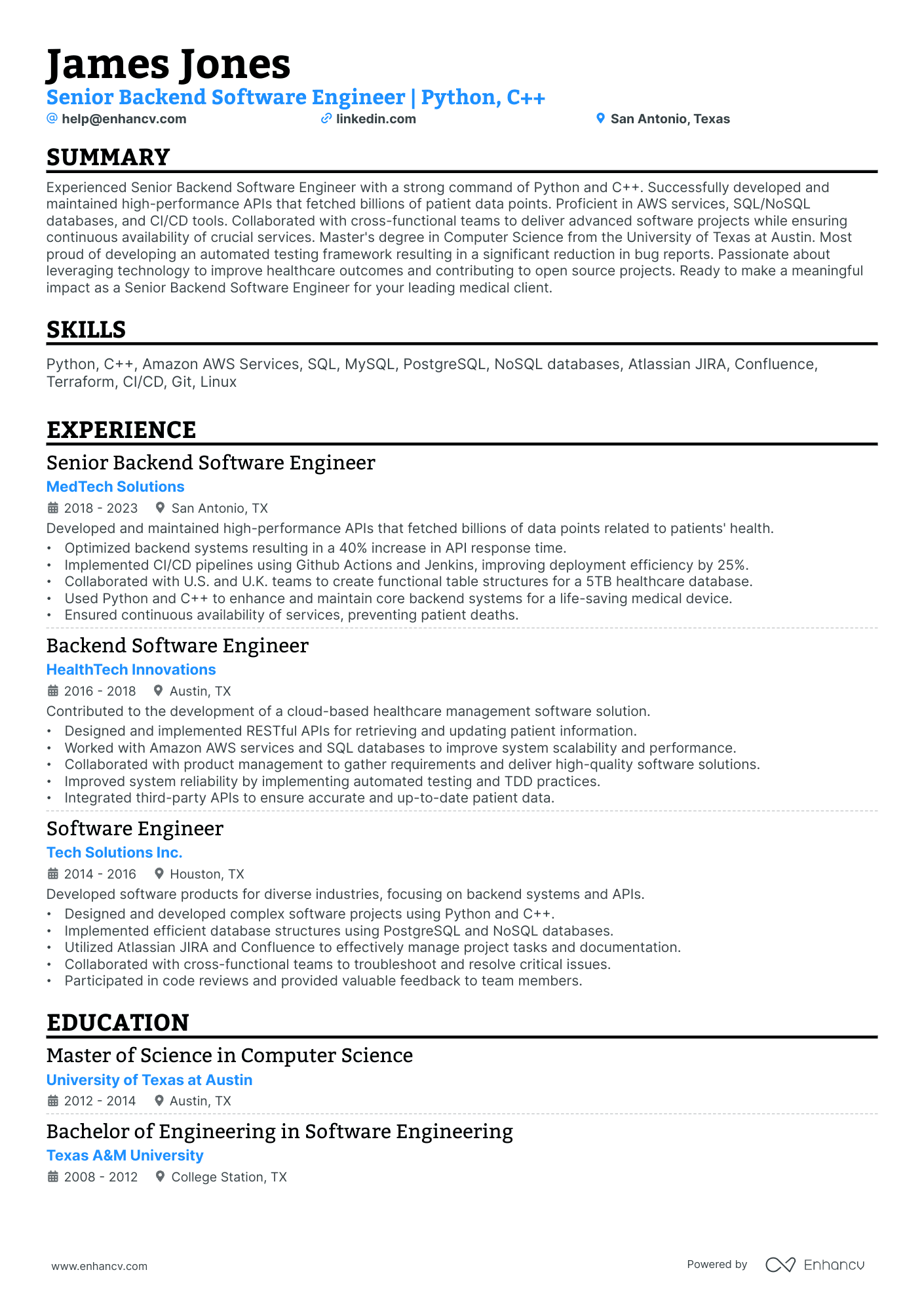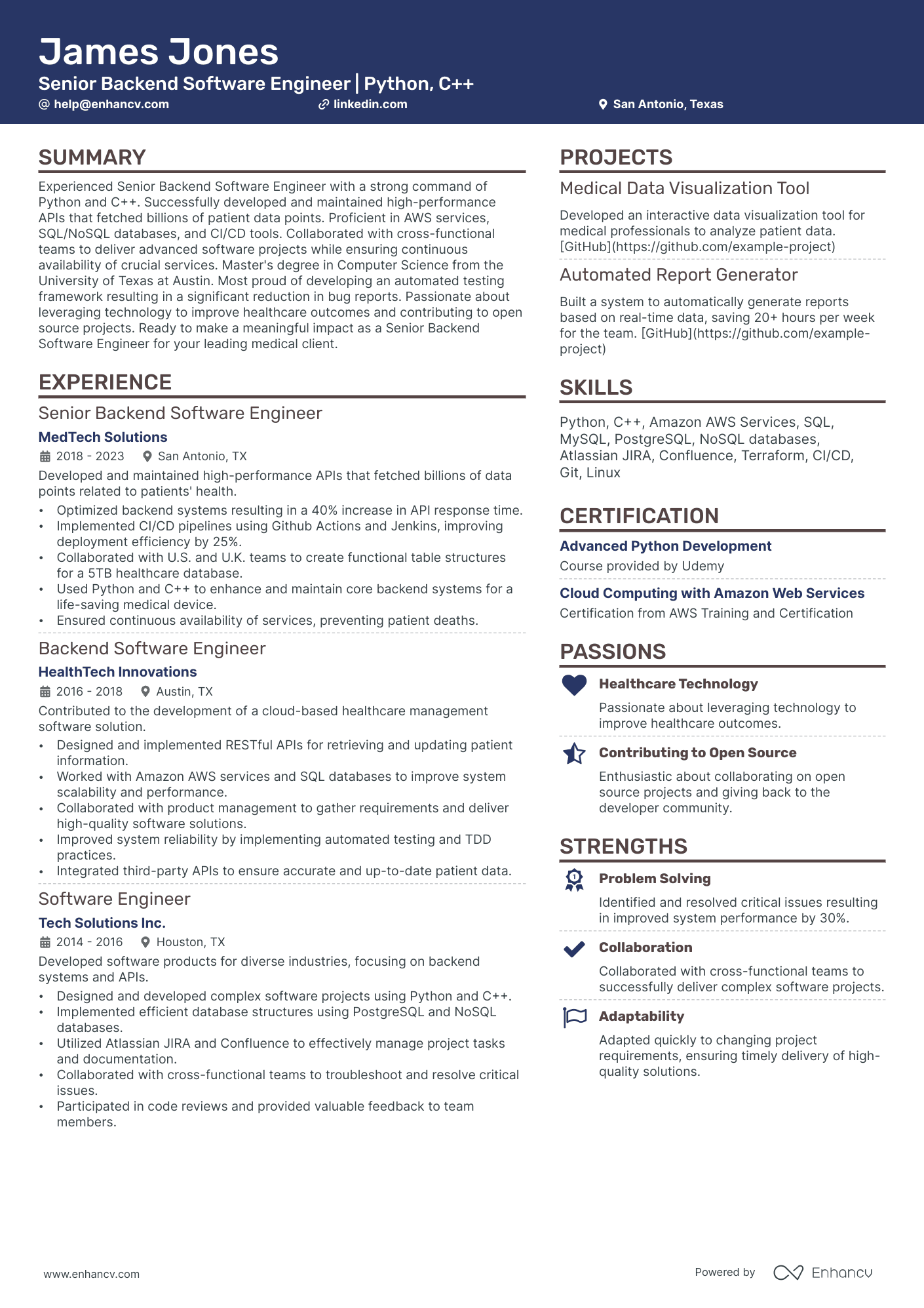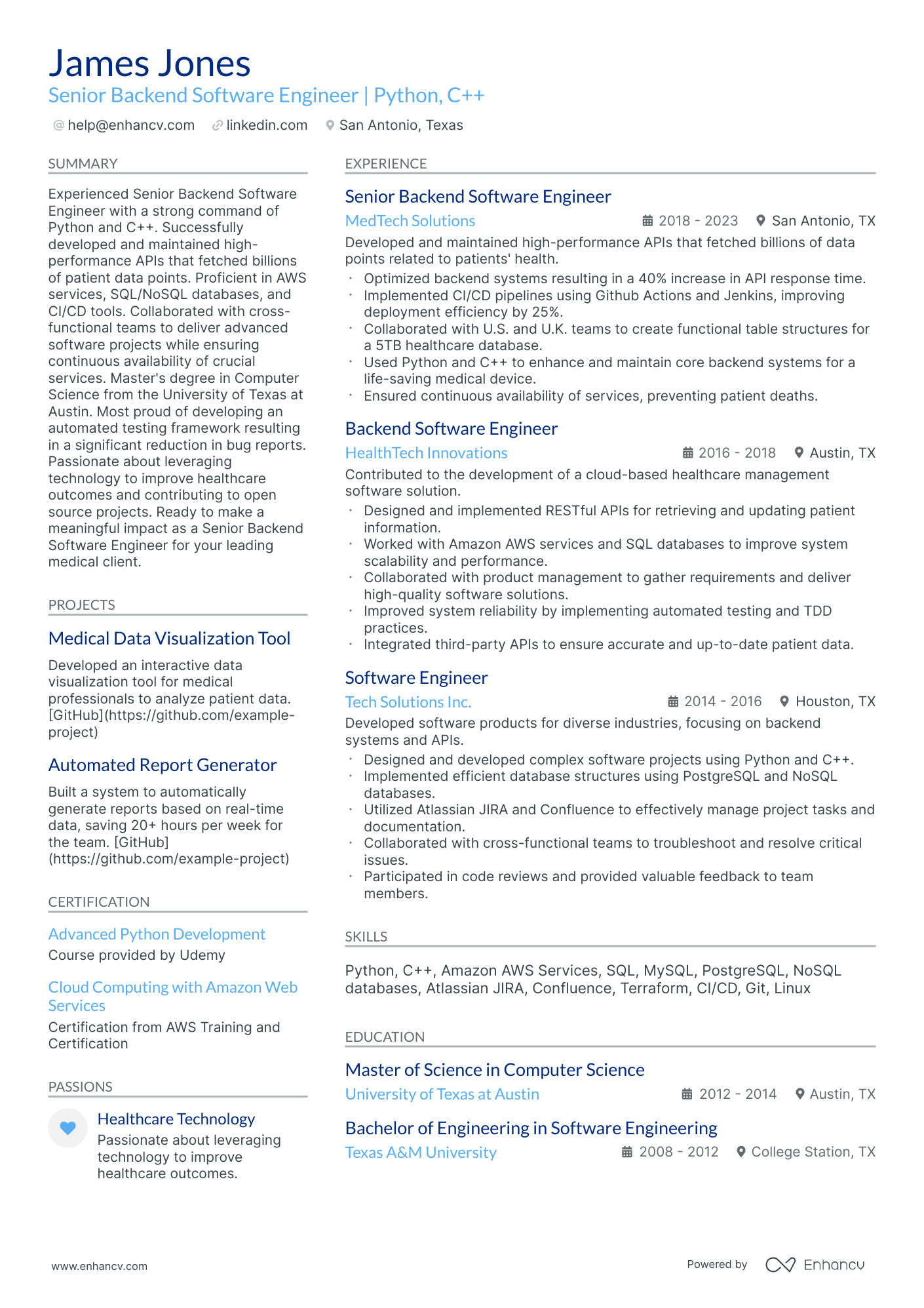One significant resume challenge for a lead data engineer is effectively showcasing their technical proficiency as well as leadership skills in a way that's easily understood by non-technical hiring managers. Our guide can assist by providing clear examples and templates on how to describe complex data projects and leadership roles, making your skills and experiences accessible to a wide range of readers.
Enhance your application for the lead data engineer role with our concise guide on how to:
- Format your lead data engineer resume, ensuring a balance between professionalism and creativity, in line with best practices.
- Align your resume with the lead data engineer job requirements by incorporating relevant industry keywords.
- Utilize distinct resume sections to highlight your skills and achievements, making a case for why you're the top pick for the lead data engineer role.
- Draw from leading lead data engineer resume examples to effectively tailor your experience.
Recommended reads:
crafting a stellar lead data engineer resume format
Navigating the maze of resume formatting can be challenging. But understanding what recruiters prioritize can make the process smoother.
Wondering about the optimal format, the importance of certain sections, or how to detail your experience? Here's a blueprint for a polished resume:
- Adopt the reverse-chronological resume format. By spotlighting your latest roles upfront, you offer recruiters a snapshot of your career trajectory and recent accomplishments.
- Your header isn't just a formality. Beyond basic contact information, consider adding a link to your portfolio and a headline that encapsulates a significant achievement or your current role.
- Distill your content to the most pertinent details, ideally fitting within a two-page limit. Every line should reinforce your candidacy for the lead data engineer role.
- To preserve your resume's layout across different devices and platforms, save it as a PDF.
Each market has its own resume standards – a Canadian resume layout may differ, for example.
Upload your resume
Drop your resume here or choose a file. PDF & DOCX only. Max 2MB file size.
Pro tip
Choose a functional resume template that offers ample space to showcase your unique lead data engineer expertise.
Elevate your data science manager resume with these essential sections:
- Header: The go-to section for recruiters seeking your contact details, portfolio, or current role.
- Summary or objective: A snapshot of your achievements and aspirations.
- Experience: A testament to your technical and interpersonal prowess.
- Skills: A showcase of your capabilities aligned with the job requirements.
- Certifications/Education: A reflection of your commitment to staying updated in the industry.
What recruiters want to see on your resume:
- Proven experience in designing, building, and maintaining data architectures.
- Proficiency in SQL and NoSQL databases, ETL tools, and data pipeline workflows.
- Expertise in data modeling techniques and knowledge of various data management systems.
- Firm understanding of big data technologies like Hadoop, Spark, and others, along with programming languages such as Python or Java.
- Evidence of leadership skills and experience managing a team of data engineers, including project management and effective communication abilities.
Recommended reads:
The experience section of your lead data engineer resume: your professional journey
The experience section is your platform to narrate your professional story. Recruiters scrutinize this section to gauge your unique value proposition.
Here are five steps to craft a compelling experience section:
- Highlight relevant roles, including the company, role description, and tenure, supported by up to six bullet points per role.
- Emphasize tangible outcomes of your contributions, using quantifiable metrics where possible.
- Integrate positive feedback or endorsements to bolster your claims.
- Ensure verb tense consistency when detailing responsibilities.
- Summarize significant achievements relevant to each role.
Explore how seasoned lead data engineer professionals have crafted their experience sections to secure roles at industry-leading firms.
- Designed and implemented scalable data pipelines using Apache Spark, resulting in a 30% reduction in data processing time.
- Led a team of data engineers in developing a real-time data ingestion system, handling over 1 million events per day.
- Collaborated with cross-functional teams to optimize ETL processes, improving data quality by 25%.
- Implemented data governance and security measures, ensuring compliance with industry regulations.
- Managed and mentored junior data engineers, enhancing their technical skills and productivity.
- Developed a distributed data processing framework using Hadoop and MapReduce, enabling efficient analysis of large datasets.
- Built a data warehouse infrastructure, integrating multiple data sources and optimizing query performance by 40%.
- Collaborated with data scientists to implement machine learning models into production systems, improving predictive accuracy by 15%.
- Led the migration of on-premises data infrastructure to the cloud, resulting in cost savings of over $200,000 annually.
- Performed root cause analysis and troubleshooting of data pipeline issues, reducing downtime by 20%.
- Developed and maintained scalable data integration workflows using SQL and Python, supporting business intelligence analytics.
- Optimized database schemas and query performance, reducing query response time by 50%.
- Collaborated with cross-functional teams to define data requirements for new product features, resulting in improved user engagement.
- Implemented data quality monitoring and remediation processes, reducing data anomalies by 60%.
- Designed and deployed a data archival system, freeing up valuable storage resources and saving $50,000 annually.
- Architected and implemented a real-time streaming platform using Apache Kafka, handling over 500,000 messages per second.
- Developed data processing pipelines using Python and Apache Beam, enabling near-real-time analytics on large-scale datasets.
- Collaborated with data scientists to operationalize machine learning models, resulting in automated anomaly detection with 95% accuracy.
- Optimized cloud infrastructure costs by implementing serverless computing, reducing monthly expenses by 30%.
- Led the adoption of DevOps practices, introducing CI/CD pipelines and infrastructure-as-code principles.
- Designed and developed an event-driven data ingestion framework using Apache Flume, improving data capture efficiency by 40%.
- Implemented a distributed data caching layer, reducing query response time for real-time analytics by 50%.
- Collaborated with business stakeholders to define data requirements and develop scalable data modeling solutions.
- Performed database performance tuning and optimized indexing strategies, resulting in a 20% improvement in query execution time.
- Mentored junior data engineers, fostering their technical growth and contributing to the team's overall productivity.
- Developed and maintained data pipelines using Apache Nifi, ensuring reliable data ingestion from various sources.
- Designed and implemented a data lake architecture on AWS S3, facilitating efficient storage and retrieval of large-scale datasets.
- Collaborated with data scientists to build predictive models for customer churn, resulting in a 10% reduction in customer attrition rate.
- Implemented data governance policies and procedures, ensuring compliance with regulatory requirements.
- Performed capacity planning and scalability assessments for data infrastructure, supporting business growth.
- Designed and implemented a real-time data processing system using Apache Flink, processing over 1 terabyte of data daily.
- Developed data integration workflows with Talend, enabling seamless data transfer across heterogeneous systems.
- Collaborated with data scientists to develop anomaly detection algorithms, resulting in a 20% decrease in false positives.
- Optimized data storage and retrieval by implementing columnar databases and indexing strategies, improving query performance by 50%.
- Led a team of data engineers in building a scalable data platform, supporting analytics initiatives across the organization.
- Developed and maintained ETL workflows using Informatica PowerCenter, ensuring timely and accurate data processing.
- Implemented data profiling techniques to identify data quality issues and improve overall data accuracy by 35%.
- Collaborated with business analysts to translate business requirements into data models and ETL mappings.
- Performed database administration tasks, including backup and recovery procedures, ensuring data integrity and availability.
- Created automated data pipelines, reducing manual effort and accelerating data delivery timelines.
- Designed and implemented a distributed data processing system using Apache Hadoop, handling petabytes of data.
- Developed data ingestion pipelines using Kafka and Apache Storm for real-time data streaming.
- Collaborated with data scientists to build recommendation systems, resulting in a 15% increase in click-through rates.
- Optimized data storage costs by implementing data compression techniques, reducing storage requirements by 40%.
- Led the adoption of agile development methodologies and established coding standards for the data engineering team.
- Developed and maintained data integration workflows using IBM DataStage, ensuring reliable and scalable data processing.
- Implemented data transformation logic for complex business rules, resulting in accurate data analytics and reporting.
- Collaborated with business stakeholders to gather data requirements and design efficient data models.
- Performed performance tuning on ETL processes, improving overall data processing efficiency by 30%.
- Provided technical guidance and mentoring to junior data engineers, fostering a collaborative team environment.
Quantifying impact on your resume
<ul>
Tips for lead data engineer newcomers launching their careers
Lacking extensive experience for that lead data engineer role? No worries.
Sometimes, hiring managers go for the unexpected candidate when they see potential.
Here's how to convince them you're the right fit:
- Opt for the functional skill-based or hybrid formats to highlight your unique professional value.
- Always tailor your lead data engineer resume to emphasize the most critical requirements, usually listed at the top of the job ad.
- Compensate for limited experience with other relevant sections like achievements, projects, and research.
- In your lead data engineer resume objective, pinpoint both your achievements and how you envision your role in the position.
Recommended reads:
Pro tip
Remember, the experience section isn't just about traditional roles. It's a space to highlight all professional learning, whether from internships, contract roles, research projects, or other relevant experiences. If it's added value to your skill set for the lead data engineer role, it deserves a mention.
Highlighting essential hard and soft skills for your lead data engineer resume
Your skill set is a cornerstone of your lead data engineer resume.
Recruiters keenly evaluate:
- Your hard skills, gauging your proficiency with specific tools and technologies.
- Your soft skills, assessing your interpersonal abilities and adaptability.
A well-rounded candidate showcases a harmonious blend of both hard and soft skills, especially in a dedicated skills section.
When crafting your lead data engineer skills section:
- List up to six skills that resonate with the job requirements and highlight your expertise.
- Feature a soft skill that encapsulates your professional persona, drawing from past feedback or personal reflections.
- Consider organizing your skills into distinct categories, such as "Technical Skills" or "Soft Skills."
- If you possess pivotal industry certifications, spotlight them within this section.
Crafting a comprehensive skills section can be daunting. To assist, we've curated lists of both hard and soft skills to streamline your resume-building process.
Top skills for your lead data engineer resume:
Apache Spark
Hadoop
Python
SQL
Data Warehousing
ETL Tools
AWS (Amazon Web Services)
Apache Kafka
NoSQL Databases
Docker
Leadership
Communication
Problem-Solving
Collaboration
Adaptability
Critical Thinking
Time Management
Mentoring
Project Management
Analytical Thinking
Pro tip
When detailing your skills, always back them up with tangible evidence, be it quantifiable results or certifications.
Optimizing the education and certification sections of your lead data engineer resume
Your education and certification sections can be game-changers on your lead data engineer resume, showcasing your commitment to professional growth.
For the education section:
- Highlight advanced education, noting the institution and duration.
- If you're currently studying, mention your expected graduation date.
- Exclude degrees that don't align with the job's requirements.
- If relevant, delve into your academic journey, spotlighting significant achievements.
When listing degrees and certifications:
- Feature those directly relevant to the role.
- Highlight recent and significant knowledge or certifications at the top of your resume.
- Provide essential details like the issuing institution and dates for credibility.
- Avoid listing irrelevant degrees or certifications, such as your high school diploma or unrelated specializations.
Remember, even if you're tempted to omit your education or certifications, they can offer a competitive edge, signaling a long-term commitment to the industry.
Best certifications to list on your resume
- AWS Certified Big Data - Specialty (AWS-BDS) - Amazon Web Services
- Cloudera Certified Data Engineer (CCDE) - Cloudera
- IBM Certified Data Engineer – Big Data (ICDE-BD) - IBM
- SAS Certified Data Management and Integration Professional (SCDMIP) - SAS Institute
- Tableau Certified Data Analyst (TCDA) - Tableau
Pro tip
If you have plenty of certifications, prioritize the most relevant and industry-recognized ones. Arrange them based on their relevance to the job at hand.
Recommended reads:
Should you add a summary or objective to your lead data engineer resume?
Choose between:
- Resume summary to match job needs with your top wins.
- Resume objective to share your career goals.
Both should tell recruiters about your best moments. Keep them short, around five sentences. Check out our sample structures for guidance.
Resume summary and objective examples for a lead data engineer resume
Seasoned Data Engineer with over 10 years of experience, specializing in big data architectures and database systems. Demonstrated proficiency in Python, SQL, and Hadoop, including hands-on experience with ETL workflows and cloud technologies. Earned recognition for implementing a data pipeline reducing processing time by 40% at XYZ Corp.
Experienced IT Specialist making a career pivot into Data Engineering. Exhibits strong analytical skills and coding prowess utilizing Python and Java, with a recent focus on database management and big data solutions. Successfully completed an intensive Data Engineering Bootcamp to transition skills effectively into the new domain.
Data Engineer with 5+ years of experience in designing, constructing, and maintaining optimal data pipeline architecture. Proven ability in using SQL, NoSQL, AWS, and Apache Kafka, coupled with a track record of developing a real-time data processing system that increased efficiency by 35% at ABC Enterprises.
Ambitious professional transitioning from Software Development to Data Engineering. Holds a robust foundation in programming with languages such as Python and Java. Adept at understanding complex systems, complemented by recently acquired skills in handling databases and big data technologies through a comprehensive certification program.
Looking forward to leveraging my strong passion for data analysis and problem-solving skills as a Data Engineer. Despite being new to the field, I bring a solid background in computer science and a deep interest in big data technologies. Committed to learning and mastering tools like Hadoop, Spark, and Scala to contribute effectively to the team.
Eager to commence my journey as a Data Engineer, bringing forth a robust understanding of algorithmic design and programming principles derived from a computing degree. While new to the profession, I am enthusiastic about honing my skills in big data technologies and database systems, aiming to contribute significantly to team projects.
Optimize your resume summary and objective for ATS
Drop your resume here or choose a file.
PDF & DOCX only. Max 2MB file size.
Extra sections to boost your lead data engineer resume
Recruiters love candidates who offer more. Share your personality or extra industry credentials. Consider adding:
- Projects showcasing standout work.
- Top awards or recognitions.
- Relevant publications.
- Hobbies and interests that reveal more about you.
Key takeaways
- Pay special attention to the tiny details that make up your lead data engineer resume formatting: the more tailored your application to the role is, the better your chances at success would be;
- Select the sections you include (summary or objective, etc.) and formatting (reverse-chronological, hybrid, etc.) based on your experience level;
- Select experience items and, consequently, achievements that showcase you in the best light and are relevant to the job;
- Your profile will be assessed both based on your technical capabilities and personality skills - curate those through your resume;
- Certifications and education showcase your dedication to the particular industry.
